Growing Green Beans for Tasty Pods and Free Fertilizer
|
© Steve Masley…Click IMAGE to Enlarge |
Growing green beans (Phaseolus vulgaris) is a pleasure. Few garden vegetables produce so much for such a small effort.
Not only do you get an abundance crunchy, sweet pods, your garden soil also gets a fertility boost from the Rhizobia bacteria that colonize the roots of legumes. See photo below.
For a continuous supply of green beans through the summer, sow small patches every 2-3 weeks until July.
Green Bean Varieties
|
Growing Green Beans in Containers
Harvesting Green Beans
How to Grow Green Beans
| Growing Green Beans Thumbnail Sketch | |
|
|
Green beans come in bush and pole varieties. To see a list of recommended green bean varieties, click Here.
Both bush and pole beans have dozens of cultivars, from broad, meaty Roma types to thin and delicate French filet beans (haricorts verts).
Pods can be round or flat, and come in multiple colors: green, purple, yellow, or mottled.
Green Bean Cold Tolerance/Season
|
Growing Green Beans |
|---|
|
|
|
|
|
|
|
|
|
|
|
|
|
|
|
|
|
|
Green beans are strictly summer plants. When growing green beans, don’t waste your time—and seeds—trying to plant them too early.
Like basil, cucumbers, and peppers, green beans languish when temperatures are cold.
Green bean seeds won’t germinate in soils below 60º F (15° C). Although some green bean seeds will germinate at lower temperatures (dark colored green beans germinate better in cooler weather than white beans), if it’s cold when they do sprout, germination will be spotty and seedlings will grow slowly.
|
…Click IMAGE to Enlarge |
Slow-growing seedlings are more vulnerable to damage from insects, slugs, and snails.
In warm weather the seedlings grow faster than the pests can eat, but in cool weather all the new growth gets munched.
Garden Preparation for Planting Green Beans
Green beans thrive in soils with healthy levels of organic matter, so it helps to lay down a layer of garden compost or well-aged manure when preparing the bed. Lay down a 1” (2.5 cm) layer for bush beans, and a 2” (5 cm) layer for pole beans. Use less if the compost is high in nitrogen.
Green beans are light feeders, and high levels of nitrogen encourage lush green growth, delay fruiting, and inhibit the nitrogen-fixing ability of rhizobia bacteria, so no supplemental fertilizer is needed—or recommended—when growing green beans in decent garden soil.
If you’re planting green beans in containers, mix 1-2 Tbs alfalfa meal or composted chicken manure per gallon of potting soil into the potting soil when you plant.
Optimal pH for growing green beans is 6.0-6.5. See Changing Soil pH for ways to adjust soil pH.
Top of Page
|
Green Bean Varieties
|
Soil Preparation
|
Planting
Watering
|
Fertilizing
|
Plant Care
|
Pests
|
Diseases
Companion Plants
|
Container Green Beans
|
Harvesting
Planting Green Beans
| Inoculating Beans and Peas |
|---|
|
Drop the seeds in a jar of water, pour the water out, then dump the moistened seeds into the jar lid. Sprinkle rhizobia inoculant over the moistened seeds—it usually takes a teaspoon or so for 30 seeds. Gently shake the jar lid around until the seeds are coated. They don’t have to be covered completely. |
If you want to get a jump on the season, start green beans in flats 3 weeks before you plan to set them out. Soaking seeds in water overnight may speed germination by a couple days, but isn’t necessary.
Even though I have Rhizobia bacteria in my soil from previous bean and pea crops, I always inoculate seeds with a Bean-Pea Inoculant before planting green beans—especially if I’m starting them in sterile potting mix indoors. That way, the roots are inoculated as soon as they crack the seed case.
Without inoculation, growing green bean roots will eventually become colonized by Rhizobia in most garden soils, but there is a delay of a few days to a few weeks, and during this delay, the plant doesn’t benefit from this symbiosis.
When you use inoculants, this symbiosis begins as soon as the roots crack the seed case. This is one reason why inoculated green bean seeds tend to produce higher yields.
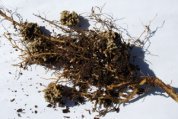
|
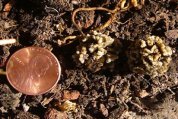
|
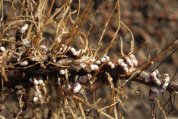
|
Rhizobia Colonies on Green Bean and Fava Bean Roots |
||
Plant 1” (2.5 cm) deep in flats or 6-packs, water, and keep them moist and warm until germination.
Once the weather warms up, transplant seedlings to their new home (see below for spacing). Or you can sow seeds directly outdoors.
Top of Page
|
Green Bean Varieties
|
Soil Preparation
|
Planting
Watering
|
Fertilizing
|
Plant Care
|
Pests
|
Diseases
Companion Plants
|
Container Green Beans
|
Harvesting
Green Bean Plant Spacing
When growing green beans, plant spacing varies, depending on depth of soil preparation and variety:
If you’re growing green beans in a single-dug bed (soil dug or tilled to 1 shovel depth, 8-10”—20-25 cm)
Plant Bush Beans 1” (2.5 cm) deep, 2-4” (5-10 cm) apart, in rows 18” (0.5 m) apart.
Plant Pole Beans 1” (2.5 cm) deep, 2-3” (5-8 cm) apart, in rows 3’ (1 m) apart.
If you’re growing green beans in a deep-dug or raised garden bed (soil prepared to a depth of 20-24”--50-60 cm)
Plant Bush Beans 1” (2.5 cm) deep on 8” (20 cm) hexagonal centers (seeds 8”—20 cm) apart in all directions within the bed).
Plant Pole Beans 1” (2.5 cm) deep, 4” (10 cm) apart, in a row along the base of a trellis.
Trellises
|
Click IMAGE to Enlarge |
If you’re planting pole beans, it’s best to set up a trellis before preparing the bed, to avoid disturbing the seedbed or young seedlings later.
I make trellises out of interlaced redwood branches because where I live, they’re attractive, durable, and best of all—free!
Pole beans aren’t picky about trellises—they just need something vertical to climb on. In the “Three Sisters” polyculture (corn, beans, and squash planted together), green beans climb up the corn stalks.
Pole beans get their nickname from the simplest form of trellis—3-6 bamboo poles stuck in the ground at the bottom and tied together at the top, like a teepee. It doesn’t have to be bamboo—any 8-10’ (2-3 m) branch will work.
If you’re growing green beans on poles, plant 8-10 seeds around the base of each pole. The vines will find their own way up the pole after they sprout.
You can also grow green beans along any conventional trellis, including two stakes with Trellis Net tied between them.
Top of Page
|
Green Bean Varieties
|
Soil Preparation
|
Planting
Watering
|
Fertilizing
|
Plant Care
|
Pests
|
Diseases
Companion Plants
|
Container Green Beans
|
Harvesting
Care and Feeding of Green Beans
Watering
Growing green beans requires regular, steady water, 1-1 ½” (2.5-4 cm) per week. Green beans are relatively shallow-rooted, so regular water is needed. This is especially important during hot, dry weather.
During the first few weeks after planting, overhead watering is good for summer vegetables like green beans, but drip irrigation is preferable once they begin flowering and setting fruit.
Defending leaves from pathogens becomes less of a priority once plants start flowering and fruiting commences. Water on the foliage of mature summer vegetables is an invitation to bacterial and fungal leaf diseases.
Fertilizing
Green beans are light feeders and require no fertilizer beyond what’s available from adding organic matter to the soil when planting green beans. Nitrogen fertilizers are counter-productive and should be avoided when growing green beans.
Green Bean Plant Care
Green beans take very little effort to grow. Harvesting is where the work comes in, with these prolific plants.
Green Bean Pests
Green bean pests include Flea Beetles, and Mexican Bean Beetles. Summer savory, catnip, and other aromatic herbs planted around the bean bed can help deter pests—see Companion Plants below.
Floating row covers can be used to protect bush bean crops from heavy infestations, but they’re harder to use on pole beans. Pyrethrin, Rotenone, and Neem extracts are approved organic insecticides that may be used as a last resort in major infestations.
Top of Page
|
Green Bean Varieties
|
Soil Preparation
|
Planting
Watering
|
Fertilizing
|
Plant Care
|
Pests
|
Diseases
Companion Plants
|
Container Green Beans
|
Harvesting
Green Bean Diseases
Bean Anthracnose is caused by the fungus (Colletotrichum lindemuthianum). It produces blotchy reddish-brown circular lesions on leaves and pods, and can significantly reduce yield and quality.
Anthracnose spreads readily in cold, wet weather. It is rarely a problem in western gardens that don’t use overhead watering, but it can be a major problem during cold spells in eastern and northern gardens. ‘Tavera’ and ‘Rocdor’ are resistant to bean anthracnose.
Bean Mosaic Virus is caused by a virus transmitted by aphids, primarily bean and vetch aphids. Control weedy relatives of beans and vetch in border areas, and plant resistant varieties like ‘Provider’, ‘Jade’ (green), ‘Tavera’ (filet), or ‘Rocdor’ (yellow).
For more information, see Cornell’s Vegetable MD Online for a series of articles on green bean diseases, complete with photos. Click Here for Cornell’s list of disease-resistant green beans.
See Preventing Vegetable Diseases for some general rules on avoiding disease problems in organic gardens.
Top of Page
|
Green Bean Varieties
|
Soil Preparation
|
Planting
Watering
|
Fertilizing
|
Plant Care
|
Pests
|
Diseases
Companion Plants
|
Container Green Beans
|
Harvesting
Companion Plants for Green Beans
|
…Click IMAGE to Enlarge |
Summer savory is a good companion plant when growing green beans. (It’s also excellent paired with green beans in the kitchen—see the recipe for Green Beans with Summer Savory below).
Planted around the edges of the patch or row, it helps deter flea beetles, bean aphids, Mexican bean beetles, and other green bean pests. Its abundant, tiny flowers provide nectar for parasitic wasps that attack pest eggs and larvae. See Attracting Beneficial Insects for more information.
Summer savory grows 1-2’ (30-60 cm) high, under the same temperature and soil requirements as green beans. Like basil and tomatoes, summer savory and green beans go together in the kitchen as well as the garden. Try sautéing some with fresh green beans.
Top of How to Grow Green Beans Section
Top of Page
|
Green Bean Varieties
|
Soil Preparation
|
Planting
Watering
|
Fertilizing
|
Plant Care
|
Pests
|
Diseases
Companion Plants
|
Container Green Beans
|
Harvesting
Growing Green Beans in Containers
|
© Steve Masley…Click IMAGE to Enlarge |
Green beans are attractive, versatile, and prolific plants for balcony farmers or anyone interested in growing vegetables in containers.
They produce a steady supply of beans at the height of the season, and their ability to fix nitrogen from the atmosphere and improve soil makes them ideal plants for renewing the fertility of planter boxes and pots. (Note: You may have to inoculate the seeds with Rhizobia if you’re planting them in sterile potting mix.
Plant green beans after heavy feeders like tomatoes, cucumbers, or spinach to help renew the potting soil.
Green beans also like the heat on a sunny balcony, as long as they get enough water.
Although relatively shallow-rooted for a fruiting plant, green beans still need a 10-12” (25-30 cm) root zone, so plant them in a 12” (30 cm) or larger pot.
They thrive in window boxes because the roots can spread out along the bottom of the box. If you’re growing green beans in a window box, it should be at least 8” (20 cm) deep, and 6” (15 cm) wide. Bush beans are usually the best choice for balcony farmers, but pole beans in a planter box are ideal for creating a quick summer screen or windbreak.
Top of Page
|
Green Bean Varieties
|
Soil Preparation
|
Planting
Watering
|
Fertilizing
|
Plant Care
|
Pests
|
Diseases
Companion Plants
|
Container Green Beans
|
Harvesting
Harvesting Green Beans
|
© Steve Masley…Click IMAGE to Enlarge |
Picking green beans stimulates continued flowering and fruit set. When growing green beans, plan on harvesting every 2-3 days once they start coming in. Filet beans in particular need frequent harvesting, or they’ll get tough and stringy.
Pods should be picked as soon as they reach mature size, but before seeds start bulging in the pods. Once seeds swell in the pods, the pods become tougher and stringier, and it sends a signal to the plant to stop flowering.
Like tomatoes and basil, green beans and summer savory work together as companion plants in the garden, and perfect compliments in the kitchen. For perfect crips-tender texture, blanch the sliced green beans in boiling water for 2-3 minutes, then flash-chill in icewater to stop the cooking process. Follow the recipe below but add the beans to the sautéed shallots and summer savory. Cover and steam for 2 minutes, until the beans are hot, no longer.
Top of Page
|
Green Bean Varieties
|
Soil Preparation
|
Planting
Watering
|
Fertilizing
|
Plant Care
|
Pests
|
Diseases
Companion Plants
|
Container Green Beans
|
Harvesting
Copyright © 2009-2025, by Steve Masley, Grow-it-Organically.com
All rights reserved
HOME | About Us | Contact Us | Privacy
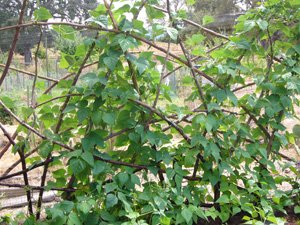

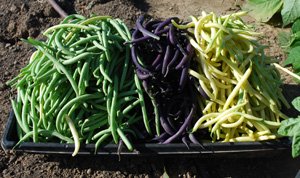

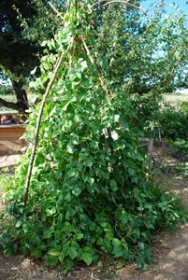
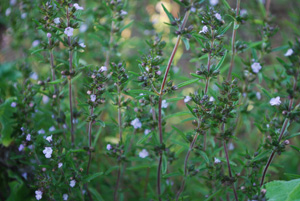
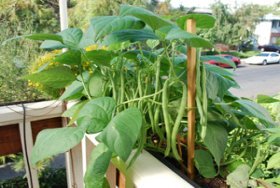
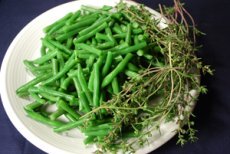
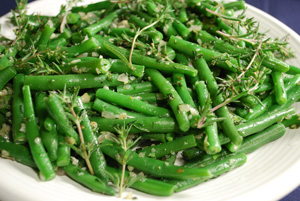
New! Comments
Have a question or comment about what you just read? Leave me a comment in the box below.